
WebLetter 1
An Occasional Publication for the Home Boat Builder
Glen-L Marine Designs - 9152 Rosecrans Ave. - Bellflower, CA 90706
In this issue
- Performance Report: Gypsy Lee Freeman describes his adventures
- Who's on the Phone?
- Fiberglassing a Planing Boat
- Steamboat Jim HarborMaster with steam engine
- Study plans
- Notes on the WHITEHALL-Wood From one of our builders
- Plywood facts
Glen-L Update
Welcome to Glen-L's WebLetter. In response to requests from readers of our hard-copy News Letter, we have included comments from builders in this first issue of our Web Letter. We will try to include more in future issues.
- We have been adding study plans on additional designs. These study plans will be available at a charge of $10.00. Check with us for availability for study plans not listed on the price list. See this issue for more information on study plans.
- Our new design, LO VOLTAGE, utilizes electric power using old outboard parts and a golf cart motor or an in-line electric motor with prop shaft. If you don't have information on this design or our latest rowing boat, FIFE, request information and we'll send you a literature brochure. Information about these and our electric boat, AMP EATER, currently being developed, will appear in our next Web Letter.
- Sometimes we forget the excitement that we had building our first boats. Mr. Freeman's letter (see Performance Report) reminds us of what a rewarding project boat building can be.
- Since this is our first electronic news letter, we are still learning how it's done. Let us know if you have any suggestions or if there is anything you would like to see in future issues of our Web Letter.
Glen Witt
President
Performance Report: GYPSY
The following letter was received from Mr. Lee Freeman in early 1994.
Dear Friends of Glen-L Marine,
In 1986 I bought a small runabout to use on local Florida lakes. It wasn't long before I found that a boat capable of larger waters and one in which I could get out of the sun would be really nice. On a visit to an inland waterway lock, I saw a cabin-cruiser with a husband and wife crew. It was then that I decided that someday I would have a boat that I could go inside of, maybe have a cup of coffee, or just relax in as I would at home.
I soon found that buying what I wanted was really prohibitive. I remembered having seen an advertisement for your boat catalog, so I found the ad and ordered your catalog. Like a kid with a Christmas wish book, I poured over the designs. My family and I discussed boat lengths. We all made promises that if I would buy the plans, the whole family would build it. My boys and I would do the "grunt" work, and my daughter would design the inside. So after debating over such a big project, and which boat would be best for us, I ordered the GYPSY plans in April 1987. I still remember laying out the plans in the yard with my children. We sat in our fictitious boat and talked about the day we would sail our boat through the locks and into the sunset.
The building of the GYPSY (Fair Havens as we dubbed her) truly became a family project. My boys learned not only about boat building, but about woodworking, electrical, etc. The boat became the subject of school papers, and a source of conversation for my children, (as well as for me). Many times their school friends (who couldn't believe anybody could build a boat) came over to help us. During the project my nephew became interested and came over after work to help. My sister and her husband volunteered to make the cabin cushions. Other friends made curtains.
In spring of 1990 the Fair Havens made her maiden voyage up the inter coastal waterway from Cocoa Beach to St. Augustine (about 230 miles round trip). A vacation we still talk about. Since then the Fair Havens has made four Florida Key Cruises. The fifth Key cruise has been planned for this June, and another St. Augustine cruise in August. Local water day cruises are a normal event throughout the year. We have found that vacations on the Fair Havens are not vacations... they're ADVENTURES!
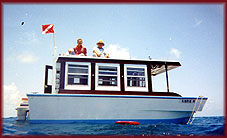
The Fair Havens is built to specs., except the side windows and an extended front roof. The roof top is a sun deck so I added a support post for the extra length. In smooth water she trues out at 32 mph. with a Johnson 140 engine. She has cruised on a plane with nine (some HEAVY) adults on board! In the Atlantic she has been in rougher water than I can take! Inside is per the plans. She carries 32 gals. of fuel, and 25 gals. of fresh water. The cabin is air-conditioned for those hot nights in Florida ports.
The children are grown now and, like so many families, have gone their ways. Recently I made a video tape of movies, pictures, and videos of them growing up, which included the Fair Havens. My plan was to give it to them, and watch it when we got together for Christmas. The part that drew the most excitement, and tears, was the building and cruising of the Fair Havens.
Little did I know that the building of the Fair Havens would play so rich a part in our family history. When I look at her I see a family member. Though she can't talk, she reminds me of precious memories, and beckons of new adventures in the future.
Thank you for all your fine plans, your help, and the encouragement that made the Fair Havens possible. If you need recommendations to customers thinking of building their own boat, put my name on the list.
Included is a picture of Fair Havens during a day of snorkeling near Alligator Reef, in the Florida Keys.
Sincerely,
Lee Freeman
St. Cloud, Florida
Who's on the Phone?
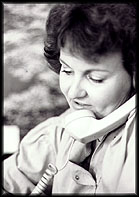
Office manager, Darla (Hilgenberg) Schooler, born in Mitchell, SD; home of the world's only Corn Palace. Her graduating class at Artesian HS: ten. Darla married Jack Schooler after he got out of the service, moved to Downey, CA in 1974. She has two daughters, three grandsons and birds. Darla came to work at GLEN-L in 1981. Darla and Jack have a home in Arizona and spend every weekend they can tending their cactus garden and watching desert sunsets. Darla is one of the cheerful voices you may hear when you call GLEN-L. She takes and processes orders, does bookkeeping, problem solving, and makes great cookies. We don't know what we'd do without her.
Fiberglassing the Bottom Trailing Edge of a Power Boat
The well radiused corner required for proper
application of fiberglass cloth is not desirable on some areas. For example,
the bottom edge along the transom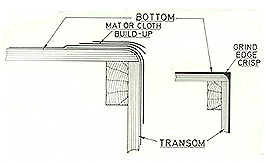 of high performance boats or along the inside edge
along sponsons of hydroplanes should have a crisp corner for ultimate speed and
performance. The illustration shows a good method for "re-crisping"
the edge. The edge is built up with pieces of scrap cloth to provide sufficient
bulk of fiberglass material and resin to be ground down to form a crisp edge.
The built up area should be faired so as to not form an abrupt "hump"
at the edge, which could detract from the performance of the boat.
of high performance boats or along the inside edge
along sponsons of hydroplanes should have a crisp corner for ultimate speed and
performance. The illustration shows a good method for "re-crisping"
the edge. The edge is built up with pieces of scrap cloth to provide sufficient
bulk of fiberglass material and resin to be ground down to form a crisp edge.
The built up area should be faired so as to not form an abrupt "hump"
at the edge, which could detract from the performance of the boat.
There is a myth that fiberglass boats last longer than wooden boats.....
Aug. 26,1995
Dear Sirs:
I have a Glen L Hot Rod boat that I built and launched in 1962. It is powered
by a 1956 Buick V-8 engine, that still operates very well. Due to advancing age
of myself not the boat, I am desirous of selling it.....
I am enclosing a flyer I made to promote the sale.
How I came to write to you is, one answer to the flyer was from a man who is
currently building about the same boat. He wanted to see a finished project. He
was quite pleased. I didn't realize you were still in business. It's
been over thirty years. .........
James Mason
Anderson Island, WA
Steamboat Jim
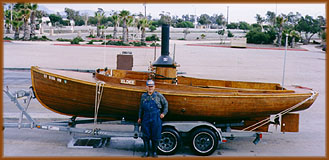
James Lesovsky of Winnetka, CA has built more than one of our "character" boats, including the HARBORMASTER, using the strip planking method. The boat went through an evolutionary process; at one time having a cabin that was later removed and a Stuart Turner steam engine installed. Jim enjoys taking the HARBORMASTER down to the local waterways and watching the stares.
For anyone interested in steam power, Jim advises to contact the INTERNATIONAL STEAMBOAT ASSOCIATION, RT 1, Box 262, Middlebourne, WV 26149; Phone, 304/386 4434.
What is a Study Plan
In our BOOK OF BOAT DESIGNS we are limited to a page or less for each design. A study plan is meant to supply more information on a design to help you determine whether it will suit your requirements. Although what is supplied will vary depending on the type of boat, a typical study plan shows drawings from the plans reduced to a smaller format. The following drawings are taken from the ODYSSEA study plans.
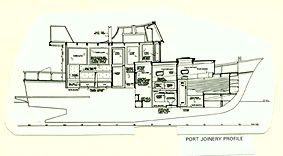 |
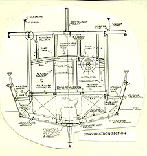 |
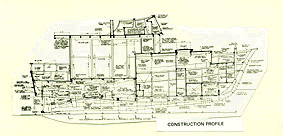 |
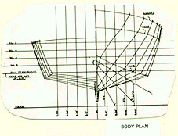 |
Also incuded: Outboard profile, deck plan, accommodation plan, construction plan, construction section, and Bill of Materials
Notes on Building the GLEN-L WHITEHALL
The following notes are alterations or amplifications of the GLEN-L WHITEHALL-Wood plans and patterns from one of our builders.
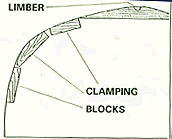
Forms: The forms for the WHITEHALL are made from plywood (1/2" min.), although not shown in plans, I would recommend fastening wood cleats around the perimeter to fasten and clamp to. And don't forget to cut the limbers in the floor timbers before mounting on forms.
Stem & Transom Knee: The plans call out laminated stem and transom knee. Although this is the traditional method of making them, they will not be visable when the boat is finished. Were I to make another WHITEHALL, I would cut these pieces from plywood, built of layers to match the thickness shown in the plans.
Resource: I found that I could order the planking (Western red cedar
or mahogany, with bead and cove) from Flounder Bay cheaper than I could find
them locally, even including shipping.
Flounder Bay Lumber, 3rd & O Sts, Anacortes, WA 98032.
Transom: An alternative transom: The plans call for two layers of hardwood at 90deg to each other; I used an inner layer of 3/4" plywood with 1"x3/4" strips of mahogany epoxied to the outside. I used this method because I planned to fiberglass the outside of the hull and this method makes the transom more stable.
PLYWOOD FACTS
The two types of plywood acceptable for boat building are exterior and marine grade. The exterior veneer surfaces are graded alphabetically, "A" being best, etc. Douglas-fir is commonly available in the U.S. and imports with various types of veneers usually can be found. Exterior and marine plywood generally use the same adhesives. However, a marine grade has solidly joined inner cores while an exterior panel will have voids.
Can you use an "AC" exterior panel? If you're building a 30' craft that's going to cost thousands of bucks, then go for the best. In contrast, if you're working on a tight budget (aren't most of us), then a lower grade plywood can be considered.
When we build a prototype of a small boat, we generally use an "AB" exterior grade. Not to save money, but to see if the panels with interior voids will make the bends without fracturing. We've had few problems with an exterior grade but, if an invisible void was at a point of stress, the panel could fracture.
E-mail us your story, your experiences building or
sailing your GLEN-L boat.
Our readers want to hear what you have to say.
Build more boats
Glen-L boats, of course